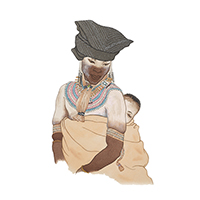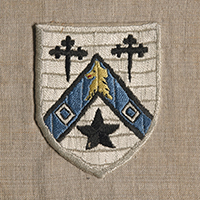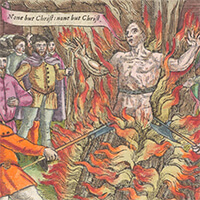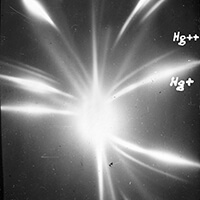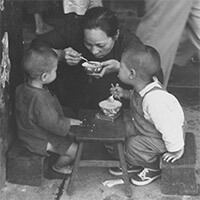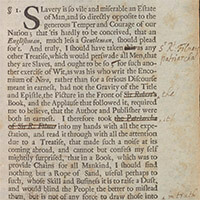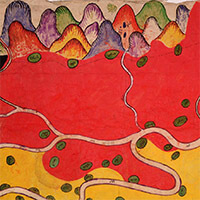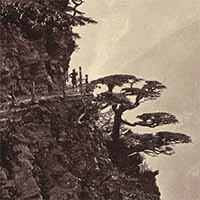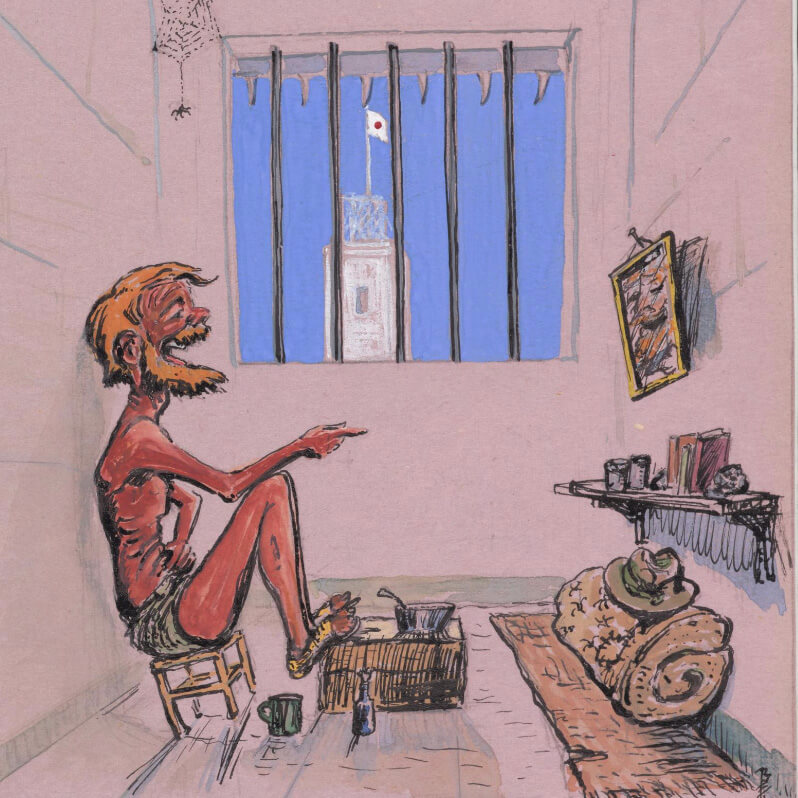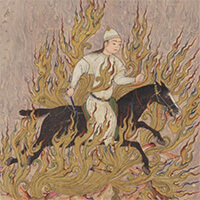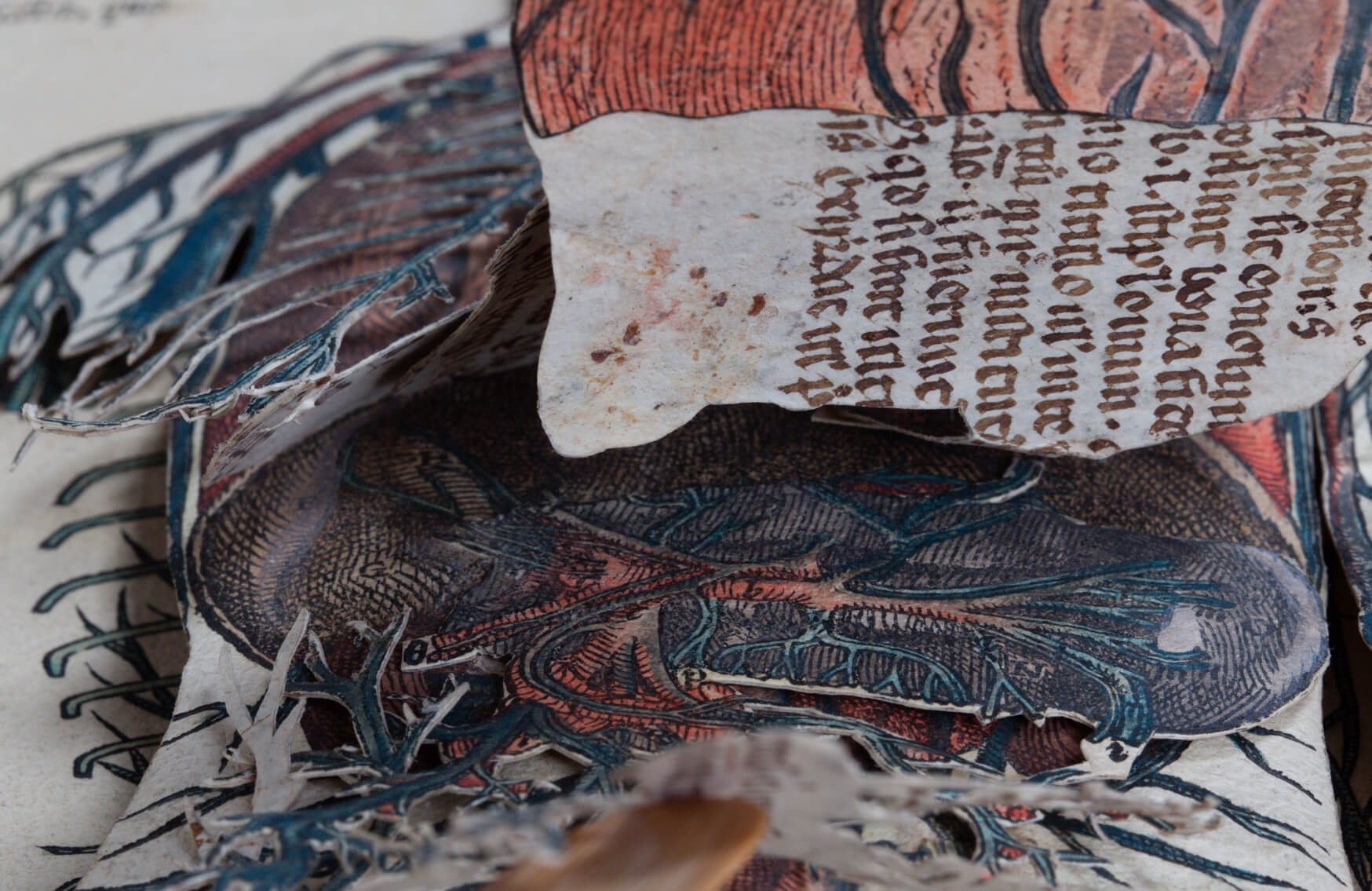Latest Updates
April Update
This month we are adding a huge variety of material to the Digital Library. The first items in our Ancient India and Iran Trust collection are two sets of photographs of artefacts from Kabul Museum, taken by Bridget Allchin in 1951. It is estimated that around 70% of the Museum's holdings have since been looted or destroyed, so this is an invaluable record of the collection.
This latest release also sees the completion of the Royal Commonwealth Society's glass plate digitisation project. Over the last three years, approximately 10,000 images have been added to the Digital Library. The release of the final 1,000 images exemplifies the collection’s great depth and diversity, this time with a particular emphasis upon Africa, and dates from the late nineteenth to the early twentieth centuries, by which time glass plates were being replaced by more practical photographic films. For more details see the Special Collections blog.
We continue to expand our College collections, with a further four manuscripts from St Catharine's and a fascinating item from Trinity Hall - their copy of The Parker Register, a list of the books and manuscripts that were owned by Matthew Parker (1504-1575) and passed to the keeping of Corpus Christi College, Cambridge.
Finally, we celebrate the addition of two individual items to the Library's collections. The Jagat Kautuka Kalpavallī is a fascinating collection of mathematical and logic problems, in the original Sanskrit, with an English translation and striking, well-executed illustrations which was acquired with the generous support of Art Fund and the Arts Council England. We are also adding a 1516 copy of the Decameron, with annotations by the Elizabethan spy William Herle, which was acquired with a grant from the Friends of the National Library's B.H. Breslauer Fund.
February Update
In collaboration with the Art Research Center at Ritsumeikan University we have expanded our Japanese Collection to over 450 items. There are many rare and visually fascinating examples, including some charming and beautiful Japanese fairy tales.
The Royal Commonwealth Society Collection adds hundreds more amazing photographs from all over the globe. A blog post, Glass plates of Oceania, South Asia, the Far East and Africa, is a great place to start exploring.
The Department of Engineering‘s annual photo competition highlights the variety and beauty of engineering. We’re excited to begin incorporating these into Cambridge Digital Library – our first “born digital” collection. A glimpse into cutting edge engineering that now sits alongside works by Newton and Darwin, whose work was equally ground-breaking in its time.
Finally, the fantastic new collection Landscape histories from the air contains around 1,500 images from Cambridge University’s Collection of Aerial Photographs (CUCAP). The total collection, dating from 1945 to 2009, comprises 497,079 photos that show not only our ancient landscapes but also how the UK’s built environment underwent radical change in the 20th century and on into the 21st.
October Update
This month we celebrate the hundred and fiftieth anniversary of the Royal Commonwealth Society with our RCS 150 collection, containing over one hundred treasures showcasing the international breadth and visual richness of the archives. Highlights include stunning images recording the costume and customs of southern Africa's peoples, intriguing watercolours painted during Australia's gold rush and fascinating selections from the photographic collections.
We are also adding a wonderful selection of lantern slides to our Westminster College collection. They depict the travels of Agnes Smith Lewis and Margaret Dunlop Gibson, the 'Sisters of Sinai'. The sisters were keen photographers, and photographed manuscripts at St Catherine’s monastery as a way of taking clear copies of original documents. Perhaps the most famous of these was Syriac Sinaiticus, the Sinaitic Palimpsest, which they discovered in 1892. However, they also took almost 300 photographs of landscapes and people during their travels. They show the people the Sisters travelled with – academics, cooks, monks at St Catherine’s –W W W W and provide fascinating glimpses into what travelling in the desert was like for intrepid ladies in the 1890s.
Finally, we are adding 37 new items to our collection of the notebooks of the botanist Oliver Rackham, taking the total to 302. Latest additions include notebooks on Epping Forest, Glasgow and Worcester.
September Update
This month sees the addition of two exciting new collections. The Westminster College collection launches with the Westminster Confession, one of the most important religious documents of the English Civil War. Drawn up in 1646, it became and remains the "subordinate standard" of doctrine in the Church of Scotland and has been influential within Presbyterian churches worldwide.
The first document in the Newnham College collection is War Work 1914-1918, a record of the work done by over seven hundred Newnham women during the First World War. With activities ranging from medical and air shelter work, through collection of sphagnum moss, to scientific and mathematical work, this volume provides an important insight into the history of the War, particularly the contribution of women to the war effort.
We are also adding a new item to our Isaac Newton collection - a notebook Newton used at school and University from the collection of the Wren Library, Trinity College. This bringing together of Newton material has been in part driven by the addition of Newton's papers to the UNESCO Memory of the World Register.
This month also sees the addition of two new manuscripts to our Queen's College collection - a copy of the Soliloquies of Saint Augustine and a beautifully illustrated Book of Hours.
Finally, take a look behind the scenes of our imaging and conservation work in this lovely video showing the digitisation of a 13th century scroll.
July Update
This month we launch Scriptorium as a collection on the Digital Library, a digital archive of manuscript miscellanies and commonplace books from the period c. 1450-1720, drawn from the collections of ten partner institutions: a number of college libraries in Cambridge (Emmanuel, King's, Queens, St John's, Trinity) as well as the Cambridge University Library, the Brotherton Library in Leeds, and other archives, such as that of Holkham Hall in Norfolk.
We are also releasing a complete set of the often gruesome illustrations from Acts and monuments, also known as Foxe's Book of Martyrs, famous for its vivid depictions of persecutions, and particularly of those Protestants who had been executed for their faith under the Catholic Queen Mary. This volume has been digitised and described by Dr Ceri Law as part of the Remembering the Reformation project.
Finally, we are adding the Aurora australis to the Christ's College collection. The first book ever written, printed, illustrated and bound in the Antarctic, it was produced entirely by members of the British Antarctic Expedition of 1907-9, and edited by Ernest Shackleton. The inside cover shows the stencil on the original packing case that was used for the book's front and back boards, which gives this volume its nickname of the 'Irish Stew' copy.
June Update
This month sees the launch of our Cavendish Laboratory collection. The Laboratory has made many fundamental contributions to the foundations and application of physics since its foundation in 1874. Fortunately, early images of many of the pieces of apparatus used in these scientific breakthroughs have been preserved, as well as fascinating photographs of everyday life in the Laboratory.
Among the many highlights are images of Maxwell's colour wheel, CTR Wilson's Cloud Chamber, Aston's Mass Spectograph, and a lovely photograph of the Cavendish Hockey team from 1932, the year of the discovery of the neutron by Chadwick and the artificial disintegration of the nucleus in the Cockcroft-Walton experiment.
Other additions include a wonderful album recording the construction of the Sukkur Bridge across the Indus in the 1880s (also see the Special Collections Blog) and the marvellous Book of hawking, hunting, and heraldry, which glories in its status as the first English book on sport, the first English printed armorial, the first English book with popular rhymes, and the first book with colour-printed woodcut illustrations in England! We have also added a further 27 botanical notebooks to our Oliver Rackham collection, bringing the total to an impressive 265, with plenty more to come.
April Update
This month we launch two exciting new collections. Our King’s College collection begins with a selection from the Schroder collection of material relating to Rupert Brooke and his friends Edward Marsh and William Denis Browne. Each of these three figures had a significant impact within the arts, albeit cut short by war in the cases of Brooke and Denis Browne. The collection includes writings by Brooke, the records of his publication history, hundreds of letters between Brooke and others, and reports from eyewitnesses of his death and burial on the Greek island of Skyros.
Our new University Library collection holds material relating to the UL itself, starting with four volumes recording the construction of the new building in the 1930s. These include amazing photographs of the construction of the Tower, and of books being transported by horse and cart from the previous library site in the Old Schools (now Caius College Library). This initial selection is being launched in support of the forthcoming exhibition Tall Tales: Secrets of The Tower which opens on 2nd May.
Other additions include a fifteenth century textbook on astronomy, William Bateson and Reginald Punnett’s laboratory notebooks on rabbit breeding and a fascinating map of Tai Shan (Mount Tai or the Exalted Mountain), the most revered of the Five Sacred Mountains of China.
March Update
February and March have been very busy months and now we are ready to release the fruits of our labours! We have produced a highly-detailed 3D model and accompanying film for the oldest item in the Library's collection, a cuneiform tablet dating to ca 2,200 BCE. The film, featuring Professor Nicholas Postgate, explains the fascinating history of the tablet, its meaning and its archaelogical context.
Our new Landscapes and Monuments collection is comprised of more than 4,000 images from the archive of Professor Garth Fowden, covering his research into the archaeology, architecture and settlements of the Mediterranean, Middle East and North Africa. These include images taken in Syria and Yemen of sites which are no longer in existentence.
The archive of The Royal Society supplies two important additions to our Newton Papers collection - a manuscript version of the Principia, and an important collection of Newton's correspondence. This is the first step in a project to bring online materials relating to Isaac Newton together and to make them more accessible to the general reader as well as to researchers. Matthew Wren's Benefactors' Book has been added to our Pembroke College collection - an illustrated register of donors to Pembroke’s library and a great work of seventeenth-century bibliography. With full transcription and translation, it has much to tell us about the construction of a college library collection and early modern Cambridge.
We have added over 1,500 historic photos to our Royal Commonwealth Society collection - the most ambitious release yet. Digitised with the generous support of the Anstruther Trust, they reflect its broad chronological scope and great geographic diversity, ranging from Douglas Moore's portraits of Hong Kong to images from the first Anglo-Boer War (1880-81). You can read more about the images on our Special Collections Blog.
Finally, we have added over fifty early printed books and manuscripts to our Japanese collection, and almost a hundred descriptions and translations to our Cairo Genizah collection. These include a multi-layered colophon, which records a succession of owners of a fine commentary on the book of Isaiah – Jacob son of Job sold it on to Josiah, who bought it to celebrate being ordained into the Jerusalem Academy in 1030/31, before the final owner left his mark: ‘[interpre]tacio esaye prophete’. The Crusader who left this note identifying the book (though, by the position of the note, clearly holding it upside-down, ignorant of how Hebrew books work) probably pillaged it during the First Crusade before ransoming it back to the Jewish community of Egypt.
And if all that has worn you out, relax by watching this beautiful behind the scenes film revealing the secrets of our digitisation process to the sound of a fantastic poem by Imtiaz Dharker.
January Update
Our January update includes three new college collections. The Christ's College collection begins with Locke's personal copy of his Two treatises of government with corrections in his hand. The copy has a remarkable history: rediscovered by an undergraduate in the 1940s, it formed the basis of Peter Laslett's critical edition of the text, which laid the foundation for the 'Cambridge School' in the History of Political Thought.
Proceeding alphabetically, the Queens' College collection features three early printed books, including the third edition of Erasmus’ ground-breaking New Testament, first published under the title Novum Instrumentum by Johann Froben in 1516. Queens’ College and its library enjoy a very real link to the Novum Instrumentum as Erasmus worked on the edition during his stay at the College in 1511-14.
The first items in the St John's College collection are the earliest printed Chinese books in the Library, including a Almanac of the thirtieth year [1676] of Yongli reign era of the Ming dynasty given to John Dacres, an English merchant of the East India Company and a pamphlet containing thirteen pieces of music, published in 1770.
Finally, we are adding The Abbey of the Holy Ghost to our Christian Works collection. The description for this small fifteenth-century miscellany has been produced by Katherine Dixon, a PhD student at the English Faculty. This close collaboration between students and the Library is a model we hope to follow in the future.
December Update
Our December release contains exciting additions to a number of our collections. We are adding three new manuscripts to our University Archives collection, including the Old Proctor's Book, a 14th-15th century compilation of statutes, charters, orders, oaths etc., and the Elizabethan Statutes of the University. Our Bateson-Punnett collection continues to grow with the addition of the ominously titled Dead Books. There are four new items for our Darwin Manuscripts collection, including a delightful notebook of 'Books read'.
Additions to the Royal Commonwealth Society photograph collection include more than 1,000 rare historic glass negatives, lantern slides and photographic prints embracing all corners of the globe. Highlights include items from the Church Missionary Society collection, which documents its work in Africa, Asia and the Middle East, and a wide-ranging selection of photographs of India, digitised as part of the library’s India Unboxed programme, illustrating its diverse people and landscape.
Finally, we celebrate the addition of Isaac Newton's papers to UNESCO’s International Memory of the World Register (including the first items we released on the Digital Library, just over six years ago). And even more finally, here's a beautiful, brightly coloured map to brighten the winter gloom!
October Update
This month sees the launch of two exciting new Cambridge collections, from St Catharine's College and the Marshall Library. The St Catharine's collection starts with two manuscripts - a thirteenth century French Bible and the beautifully illustrated Life of St Margaret. The first item in the Marshall Library collection is the publisher's proofs of the Principles of economics, containing extensive handwritten annotations and diagrams by Alfred Marshall himself.
We have also made additions to our Royal Commonwealth Society collection - a set of photographic materials relating to India, including this stunning panorama of the Himalayas and these amazing 19th century photographs by Samuel Bourne and Charles Shepherd. Finally, we have added twelve new notebooks to our Bateson-Punnett collection, and started the process of enriching descriptions in our Tennyson collection.
August Update
This month sees the launch of Voices of civilian internment: WWII Singapore from the Royal Commonwealth Society collections. This unique archive, conserved and digitised with the support of the Wellcome Trust over a two year period, powerfully brings to life the experience of civilians who were held at the Changi and Sime Road civilian internment camps between 1942 and 1945. The records will be of great interest to the families of internees and a wide range of researchers, since internees were reluctant to speak about their traumatic ordeal.
A further addition to our Royal Commonwealth Collections is RCMS 82, a watercolour panorama depicting the sea prospect of Fort St. George, dating from c.1750. This beautiful item will feature in the University's India Unboxed exhibition season.
We are also adding two fascinating items to our Cambridge University Archives collection. UA P.I.3 is a hand-drawn and coloured plan for laying out The Backs at Cambridge by Lancelot 'Capability' Brown, the famous landscape architect. In April 1776, the University Senate agreed he should be paid £50 for a plan of improved landscaping as a unified park for land on either side of the river Cam from Peterhouse to Magdalene College. Presented to the Senate in 1779, it was not adopted. UA CUR 1.2.1a is the earliest surviving of the University accounts, dating from 1363. It includes an inventory of books kept in the University’s common chest which predates the foundation of the Library by more than fifty years. A detailed description of the early catalogues of the Library can be found on our Special Collections Blog.
Finally, our Christian collection sees the addition of Codex Macedoniensis, a 9th century Byzantine manuscript of the four Gospels written in a Greek uncial script.
July Update
This month sees the launch of our Royal Asiatic Society collection with three remarkable Persian manuscripts currently on long loan to the University Library. The Shahnama of Muhammad Juki was copied in Herat between 1440-5 and is considered to be one of the finest Timurid manuscripts of the 15th century. The Gulistan of the poet Sa’di was completed in 1583 in Fatehpur Sikri. It is noted not only for its exquisite paintings of birds and animals which decorate the pages of the text but also for its colophon portrait which depicts the eminent scribe Muhammad Husayn al-Kashmiri known as Zarrin Qalam (Golden Pen) and the artist, Manohara as a youth. The Kitab-i Mathnawiyyat-i Zafar Khan is a beautifully illustrated autograph copy of the verses of Ahsanallah b. Abu 'l-Hasan, entitled Zafar Khan, written in Lahore in 1663.
Last month saw the release of a fascinating short film about MS Add.1464, one of our most famous Sanskrit manuscripts, as part of the University's India Unboxed programme. The video has now been added to the manuscript description so you can learn more about the item and turn the leaves at the same time.
June Update
This month sees the launch of our Bateson-Punnett Notebooks collection, revealing the research which lead to the founding of experimental genetics in Britain. Through their collaborative experiments on poultry and sweet peas, Bateson and Punnett discovered some of the fundamental processes of Mendelian genetics, including complementation and the first example of autosomal (nonsexual chromosome) linkage. We are starting with an initial selection of their Poultry Notebooks, and more material will be added over the coming year.
We are also adding more than 70 items to our Japanese collection, including two remarkable works on the subject of flower arranging. Yuishinken kadensho, which was recently purchased by the Library with the support of Art Fund and the Arts Council England / Victoria and Albert Museum Purchase Grant Fund, is one of the earliest extant examples of a Japanese guide to flower arranging. It shows flowers, branches, and leaves arranged with consideration of the occasion, the size of the vase in relation to the natural materials used, and the arrangements' placement in relation to hanging scrolls. It is an example of a text of secret transmission, and the first colophon includes an injunction against showing it to outsiders. Ikenobō rikka no zu is a seventeenth or eighteenth century manuscript album representing masterworks of the Ikenobō school with a series of fifty hand-painted illustrations in vivid colour.
Finally, thanks to the project ‘Medieval Medicine’ that has been running in the Genizah Research Unit, funded by the Wellcome Trust, we have added more than 1400 new items to our Cairo Genizah collection relating to the history of medicine in the medieval Genizah world: these include works by Galen and Hippocrates, as well as medical recipes, doctor’s prescriptions and dodgy pseudo-medical advice. One recipe is aimed specifically at ‘ hairy women’ and is for a depilatory cream whose active ingredient is bird excrement (T-S Ar.11.22).
May Update
The addition of a further 69 notebooks sees the Oliver Rackham collection grow to 79 items, including notes on Bradfield Woods, Chalkney Wood, Derbyshire, Hatfield Forest and Staverton Park. Much of the digitisation has been generously funded by private donation, with more to be added over the coming months.
New to our Royal Commonwealth Society collection is Reminiscences of Bombay, 1905, which features an exquisitely illuminated welcome address to H.R.H. the Princess of Wales presented by the women of Bombay, and fourteen full-page watercolours of Indian women by the artist Manchershaw Fakirjee Pithawalla. The signature of H.M. Queen Mary can be found at the front of the volume.
Five new items have been added to our Japanese collection, including The Tale of the Hollow Tree, a 17th century copy of the oldest extant full-length story in Japan. Thought to originate from the late 10th century, it tells the story of a man named Kiyohara Toshikage and his descendants, who are taught the secret technique of playing a Japanese harp by an immortal.
Finally, our Transit of Venus collection continues to grow, with the addition of the Waimea Station Journal by Richard Johnson, one of the group of observers sent to the Sandwich Islands (Station B). Written up as part of the records of the expedition to observe the 1874 transit, it contains information about the transporting of, setting up and observing with the expedition instruments, as well as an interesting account of the encounter between the expeditionary party and the indigenous people and settlers in the area.

April Update
This month sees the launch of the Sidney Sussex Collection with the Samuel Ward Notebook. Dating from c.1600 it contains the earliest known draft of any part of the King James Bible, and also represents the only extant draft of the work in a hand definitively belonging to one of the King James translators themselves.
We are also adding three of E.G. Browne's diaries to the Pembroke College Collection, recording his travels in Turkey and Iran. A short film explaining the significance of the diaries, and the process of their digitisation can be found on the Pembroke College collection page. Staying with film, take a look at the fascinating process of conserving and rebinding the Red Book of Thorney, a 14th century cartulary from Thorney Abbey near Peterborough.
Our Cambridge University Archives Collection has two new items of immense significance in the history of the University - the Charter of Edward I (1291/2) confirming the privileges of the University, and the Grant of Arms to the University, dating from 1573.
Finally, we are adding a copy of the 18th century Ode to Mukden to our Chinese Collection, including a full transcription of the Chinese text.

February Update
This month sees the launch of four new collections - Cambridge University Archives, Tennyson, Montaigne's Library and Pembroke College.
Our Cambridge University Archives collection begins with two significant manuscripts. The first is a volume of inventories of books, records and other movable property of the University, ca 1420-1660, including the earliest surviving catalogues of the archives and the library. The second is the magnificently illuminated two volume Book of privileges and liberties of the University of Cambridge, commissioned by alumnus Robert Hare, and presented to the University in 1590. It includes fascinating illustrations of the burning of weights and measures by the University Taxors and of the Black Assembly, at which the town authorities were obliged to swear obedience to those of the University.
Our new Tennyson collection features a selection of the poet's manuscript notebooks held at the Wren Library, Trinity College, Cambridge. These include the earliest extant full-scale draft of In Memoriam, Tennyson’s most famous poem. The collection is the first step towards the development of a comprehensive digital archive of Tennyson's manuscripts.
The Montaigne Library of Gilbert de Botton is a remarkable collection of books connected with the life and times of Michel de Montaigne (1533–1592), including ten volumes from Montaigne’s personal library. The selection presented on the Digital Library includes all ten books formerly owned by Montaigne, as well as other copies of works known to have influenced his writings. Particularly significant is Montaigne's own copy of Lucretius’ De rerum natura (1563), a text heavy with his annotations and the date when he finished reading it, 16 October 1564, at the age of thirty-one.
Our Pembroke College collection starts with the Album Amicorum, an early autograph or ‘commonplace book’, and one of Pembroke Library’s most valuable and beautiful treasures. This superb album comprises contributions (signatures, inscriptions, poems, drawings, engravings, coats of arms) to the renowned Flemish cartographer, geographer and antiquary Abraham Ortelius (1527-1598) from a distinguished and international group of his friends, including William Camden, Gerhard Mercator and John Dee.
Finally, a busy month ends with our release of two unique fascicules from the Yong-le da dian 永乐大典 ('Great Compendium of the Yong-le reign-period'), the largest example of the Chinese literary genre known as lei shu 类书 ('book of categories'). You can read about the fascinating history of this manuscript and its survival in our detailed description.
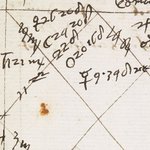
December Update
December sees the launch of the Forman and Napier Casebooks, one of the largest surviving sets of medical records in history, made up of records of 80,000 consultations by the astrologer-physicians Simon Forman and Richard Napier between 1596 and 1634. This release, a page-turning presentation of the 64 volumes which make up the collection, is the first stage of a collaboration between the Casebooks Project and the Digital Library.
We are also adding an important new item to the Peterhouse collection. The Whittle Power Jet Papers which chart the development of the turbo-jet engine during the Second World War, provide a unique insight into the challenges of developing a novel aircraft propulsion system, and from time to time illustrate the frustrations of a young and impatient inventor working with a large and rather staid manufacturing company.
Other additions include a beautiful 'Nature Printing' book which belonged to Dr Erasmus Darwin, grandfather of Charles Darwin, two 19th century Chinese maps charting operations against the Nian rebels, and an intriguing 17th century manuscript catalogue of the library of All Saint Church in Lund, Yorkshire.
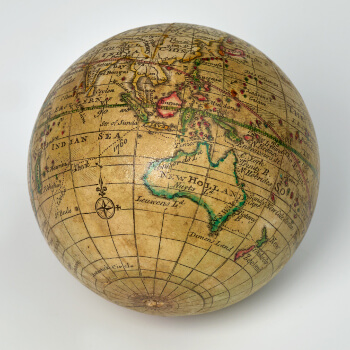
November Update
This month sees the launch of our Curious Objects collection, in support of the Library's new exhibition on some of the unusual and unexpected items in our holdings. From an ostrich feather and ectoplasm to an old boot and beard hair, the curious objects span every era of human history from the Stone Age to the Space Age. Our online collection also includes some stunning 3D models, such as this pocket globe.
We are also adding two new items to our Chinese collection. The Yi yu tu zhi is the sole surviving copy of a fifteenth century Chinese bestiary, with vivid depictions of people, places and animals both real and imaginary. Particular highlights include this realistic rhinoceros and this rather less accurate giraffe. The Shou shan quan tu is a map covering the whole of Beijing (Peking) within the city walls, intended for practical use by travellers. Probably a 19th century copy of a similar print in the National Library of China, it shows residential streets, temples, palaces, gardens, rivers, wells and bridges.
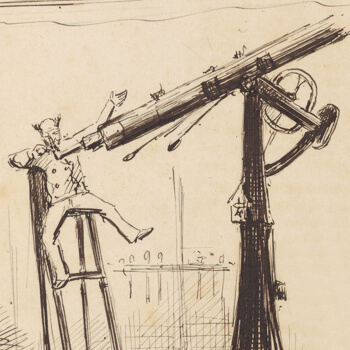
October Update
This month sees the launch of our new Transit of Venus collection, drawing on Library and private archives to give a vivid official and personal account of the British expeditions of 1874. The central individual around whom the material has been selected is Captain George Lyon Tupman of the Royal Marine Artillery (1838-1922): the chief organiser of the British effort both before and after the transit itself and chief astronomer for Station B. This collection brings together a selection of material from Tupman’s papers in the archive of the Royal Observatory, Greenwich, from the papers of the Astronomer Royal, George Airy, and from the private collection of Tupman’s descendants, including two albums of caricature drawings following “The Life and Adventures of Station B”, by one of the seven observers, Lieutenant E.J.W. Noble.
Noble’s caricatures give us the most unique and lively view of the expedition. We get to know the observers, their work, their frustrations and their entertainments. They, the instruments and some locations are drawn so as to be recognisable. The observers are well introduced at the top of this image, which below shows the complexities of sea travel, particularly when your baggage consists of tonnes of specialist equipment.
We are also adding Darwin’s notes on heliotropism and sleep to our Darwin Manuscripts collection, and an 18th century copy of a collection of discussions between Confucius and his disciples to our Japanese collection - the only copy of this work in Europe.
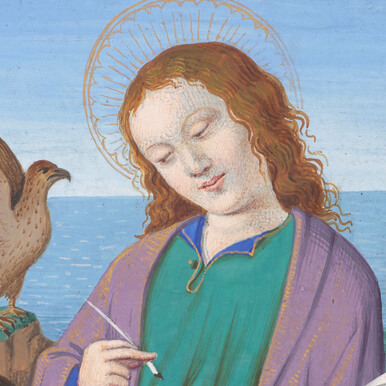
August Update
This month sees the addition of two intriguing items to our Christian Works collection, both currently on display in the Fitzwilliam Museum's exhibition Colour: The art and science of illuminated manuscripts. Add.4126 is a Book of Hours once thought to date from the 16th century, but now known to have been produced in the mid nineteenth century by the miniaturist Caleb Wing. Despite the fact that it is thought to have been created as a modern replica rather than as a forgery, it was sold as a manuscript 'from the time of Francis I' in 1892 and dated to c.1520 on its accession to the Library. Dd.1.14 is a complete text of the Bible from the second quarter of the 14th century, copied by an Italian scribe, with the decoration being completed in England.
We are also adding an incredibly detailed set of photographs taken in New Zealand in the 1870s to our Royal Commonwealth Society collection, and an illustrated collection of short stories from the 18th century to our Japanese Works collection.
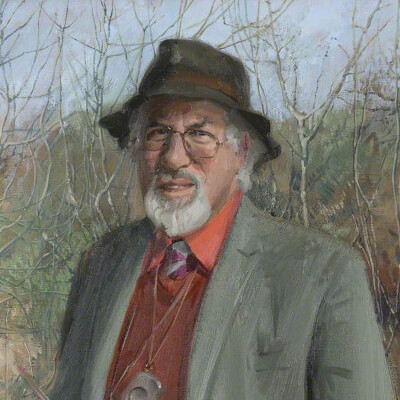
July Update
Our July release sees the launch of two new collections closely related to Cambridge. The Oliver Rackham collection, presented by Corpus Christi College, holds a selection of notebooks belonging to the famous botanist, a Fellow of the College from 1964 to his death in 2015. The work of observing the landscape, and writing about his findings, was a continuing and central preoccupation throughout Rackham's life. The red notebooks in which he recorded his observations, often including sketches of plants and fungi, form an unbroken series from his youth to his death. A parallel series of blue, location-specific notebooks tend to contain more structured data in the form of maps and tally charts showing incidence of plant species. An initial selection of ten notebooks is presented in this release.
The new Downing College collection opens with a fascinating set of miniature portraits of members of the University in the 1790s. Painted by Sylvester Harding and commissioned by Sir Busick Harwood, they depict scholars from Emmanuel, St John's, Trinity, Jesus, Queens', Peterhouse, Pembroke Hall, Clare Hall, King's, Trinity Hall, Gonville & Caius and Christ's.
Additions to existing collections include Charles Darwin's own copy of the first edition of On the origin of species, with annotations incorporated into the second and later editions, and six further items to our Darwin Manuscripts collection, bringing the total to 113. A busy month also sees three new items in our Japanese collection, including a compendium for female students from 1842. Finally we are grateful to the Friends of Cambridge University Library for funding the digitisation of Sinte Bernard[us] Souter tot onser lieuer vrouwe[n] Maria, a beautifully printed Dutch devotional work dating from 1491.
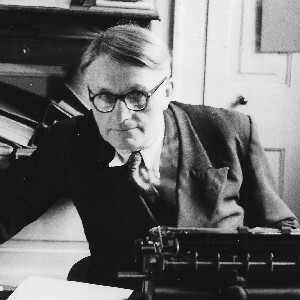
June Update
Our June release sees the official launch of the Joseph Needham collection - a remarkable set of diaries and photographs from the famous Cambridge sinologist's travels in wartime China.
They paint a vivid picture of war-torn China, of scientists doing amazing work in even more amazing conditions - in caves, temples and hastily constructed labs in remote locations – and the trials and tribulations of reaching them on washed-out roads in a cranky old truck
Our second new collection, the Fairbank Papers, is also comprised of wartime diaries and photographs. Thomas Fairbank served as an army surgeon during the First World War, first on the Western Front and later in Salonika. His papers give us an insight into his first-hand experience of the horrors of war, as well as the lighter side of army life - from dealing with heavy casualties at the Second Battle of Ypres to the production and performance of pantomimes.
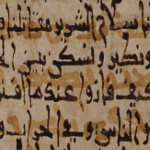
April Update
This month sees the release of the Mingana-Lewis Palimpsest, a fascinating manuscript containing portions of two ancient Qurʼāns hidden beneath a 10th century Christian text.
The manuscript has a long and fascinating history, but only now, through a combination of digital techniques and years of research, has Dr Alba Fedeli produced the first complete edition of the Qurʼānic undertext.
Our presentation includes images of the Christian overtext and the enhanced images of the Qurʼānic undertext created by Dr Fedeli as part of her research. Full page-by-page transcription is available under the "View more Options" tab.
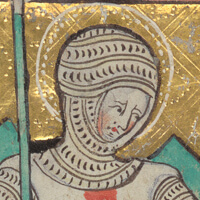
March Update
This month sees the release of our new Lines of Thought Collection, celebrating 600 years of the University Library. Among the many treasures are the Library's copies of Shakespeare's First Folio and the Gutenberg Bible, as well as a fascinating 3D image of one of our Chinese Oracle bones, dating from 1400-1200 BCE. More information on the Library's 600th celebrations can be found here.
We have also added a number of photographic collections to the Royal Commonwealth Society Collection, including albums on Australia and New Zealand, Newfoundland and New Guinea, in addition to a breathtaking panorama of Dunedin.
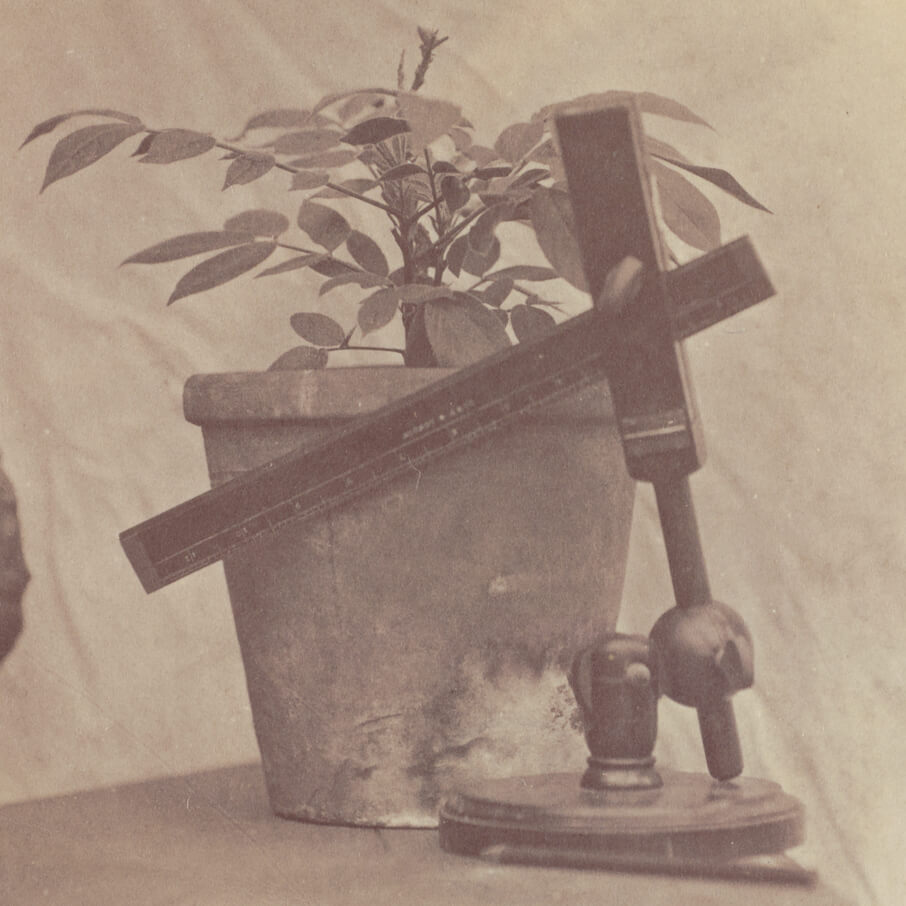
December Update
Our December release sees the addition of ten new items to our Darwin Manuscripts Collection. Included amongst these are some fascinating early photographs of Darwin's experiments on plant growth, followed by pressed cuttings of the plants themselves.
Also included are Darwin's manuscript notes on cross and self fertilisation, and on sexual selection in mammals.
This release brings the total number of images online in the Darwin Manuscripts Collection to over 20,000, with more to come in the New Year!

November Update
Our November release sees major additions to our online holdings of early Near Eastern fragments. We have added over 300 Arabic papyri to our Michaelides Collection, comprising personal letters, legal texts, accounts, literary texts, recipes and other documents, the majority of which have not yet been subject to academic study. This brings to an end the first phase of a project to put the complete Michaelides Collection online.
We have also added over 300 fragments from the newly conserved Lewis-Gibson collection, including L-G Arabic 1.23, an early leaf from Saadya Gaon's Book of Beliefs and Opinions. Saadya Gaon (882–942 CE) was one of the most influential Jewish thinkers of the early Middle Ages and this influence can be seen in the hundreds of copies of his writings — many from works that had been lost — that have been discovered in the Cairo Genizah.
Lastly, we have added around 200 letters and legal documents from the Taylor-Schechter Genizah collection that shed light on community affairs. T-S 16.149 is a 13th-century letter sent from Alexandria to the head of the Jewish community in Cairo, explaining that their local judge had rudely and pointedly left while a visiting Iraqi preacher was in the middle of delivering a sermon. The Alexandrians wrote their letter in support of the visiting preacher and to explain that their local judge had in fact behaved badly.
Moving away from fragments, we are adding four new items to our Christian Collection, including the Red Book of Thorney, a fourteenth century cartulary of Thorney Abbey near Peterborough. This intriguing manuscript has been released to coincide with a free public talk on its content and conservation to be held at the University Library on Saturday 14th November (details here).
And in other news, we are proud to announce that the Board of Longitude Papers and the Equatorie of the Planetis have both been shortlisted for the British Society for the History of Science Ayrton Prize, recognising outstanding web projects and digital engagement in the history of science, technology and medicine. Members of the BSHS can vote via the link at the bottom of the page.
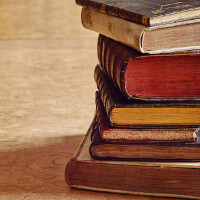
September Update
In September 1715, King George I made a gift to Cambridge University Library that would change it for ever - 30,000 books and manuscripts, trebling the collection in size overnight. This release includes highlights from that collection, released to accompany the Royal Library Exhibition running between October and December 2015 at the University Library. Amongst the remarkable items are the Moore Bede, one of the earliest source manuscripts for the Historia Ecclesiastica; the Book of Deer, a gospel book widely regarded as the earliest manuscript produced in Scotland; the beautifully illuminated 13th century Moore Psalter; and the Life of Edward the Confessor, a unique thirteenth-century source for an Anglo-Norman life of the saint.
We are also launching a new Maps Collection. The Map Department of Cambridge University Library holds 1.3 million maps and over 40,000 atlases and books on cartography, covering the whole world in a range of scales, from detailed topographic maps showing the lie of the land and the man-made features resting upon it, to world maps showing ocean currents or time zones. This initial release concentrates on maps of Cambridge, from the first complete plan of the city in 1574 by Richard Lyne to William Custance’s map of 1798, before the great changes that affected the city during the early part of the 19th century.
Finally, we are adding an important collection of historical photographs of Sri Lanka to our Royal Commonwealth Society Collection, providing strong visual records of specific events, of those living and working on the island, and of the natural and built environment.
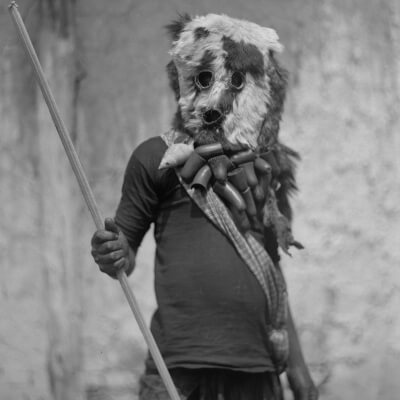
August Update
This release includes an important addition to our Royal Commonwealth Society collection. Thomas Dalrymple’s extraordinary photographs of the the former British Cameroons (now Nigeria) in 1937-1942 give a vivid insight into everyday life, ritual and social hierarchy.
We are also adding around 350 newly-conserved fragments to our Lewis-Gibson collection, including leaves from large-format Bibles as well as smaller-format Bibles for personal use. L-G Bible 2.5 is a leaf from one such small-format Bible, but - unusually - has the full complement of masoretic notations in the margins.
L-G Bible 3.53 has the Judaeo-Arabic Bible translation of Saadya Gaon given after each verse, but what is special about this fragment is that its scribe was none other than Samuel ben Jacob. Samuel also produced a fine Bible codex in Fustat in 1008-9 CE, which would survive to become the oldest complete manuscript of the Bible - now known as the Leningrad Codex - and the basis for modern printed editions. The date of his other works, including this Judaeo-Arabic Bible translation, is unknown, but we can assume that it dates to a similar time at the end of the 10th century or the beginning of the 11th. Other leaves from this same manuscript have also been found in other Genizah collections (http://www.lib.cam.ac.uk/Taylor-Schechter/fotm/november-2009/).
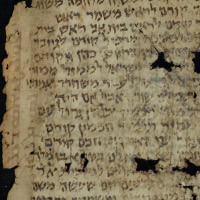 22/07/2015
22/07/2015
July Update
This release sees the launch of our new Lewis-Gibson collection with an initial selection of the 1700 medieval Jewish manuscripts jointly purchased by Cambridge University Library and the Bodleian Libraries, Oxford in August 2013. The collection includes rare and unique items such as drafts of Maimonides’ literary works, large and handsome leaves from 11th and 12th century Bibles, early Christian Palestinian Aramaic palimpsests, and an eyewitness account of the Seljuk Turks’ 11th-century invasion of the Holy Land. An article on the conservation of the Lewis-Gibson collection can be found on the Special Collections Blog.
Our latest additions to the Royal Commonwealth Society Collection focus on the history of Ghana with a wonderful range of photographs taken between 1900 and 1970, digitised in memory of Michael Fuller, and generously funded by his family. They include a 1910 panorama of Accra (Y30448A), an album on West African Railways (Y30448W), records of the Volta River Project and Tema Harbour (Y30448T), scenes of the cotton industry (Y30448U), Gold Coast castles, (Y30448J, Y30448N), soil erosion and farming (Y304E, Y3011U), Achimota College (Y30448H, Y30448J), the inauguration of the University of Ghana (Y30448F), No.218 Gold Coast Bomber Squadron (Y30448M), and the funeral of Asantehene in 1970 (Y30448R).
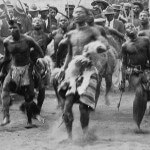
June Update
This release sees the launch of our new Royal Commonwealth Society collection. The Royal Commonwealth Society Library collections are a treasure-trove of information, pictorial and written, print and manuscript, focussing on the Commonwealth and Britain's former colonial territories. This initial selection highlights the range and scope of our holdings, from spectacular panoramas of Bombay and Simla through to some striking examples from the RCS photographic collections - Sir Henry Norman's images of late nineteenth century French Indo-China, China, Malaya, Siam, Korea and Japan, a set of mounted prints of Lourenço Marques (Maputo, Mozambique), and a group of spectacular panoramas of Hong Kong, Canton (modern-day Guangzhou), and Macau.
We are also adding a further eight items to our Darwin Manuscripts collection, bringing the total so far to seventy seven complete volumes. Among these is a fascinating collection of photographs relating to Darwin’s work on expression. Finally, we are making an important addition to our Christian collection with an 11th century copy of Alfred the Great's translation of Gregory the Great's Pastoral Care.

May Update
Our May release sees the launch of our new Chinese collection. Our initial selection shows the temporal range, diversity of media and variety of subject-matter contained within the collection, from the three-thousand year old Oracle Bones (the oldest documents in the Library), to unique manuscripts and printed books, historical documents and epigraphical rubbings. A particular highlight is a unique copy of a study of calligraphy and painting, described as ‘perhaps the most beautiful set of prints ever made’.
Also included is a very attractive collection of nineteenth century Indian mica paintings, comprising thirty-six miniature portraits from Trichinopoly, dated 1869. Incredibly for objects of such an ephemeral nature, the micas reached the Library still brilliantly coloured and fairly intact, but they had become too fragile to handle. A project to conserve and rehouse them is described on the Library's Special Collections Blog.

April Update
Our April release sees the launch of our new Michaelides Fragments collection. Including personal letters, legal texts, accounts, literary texts, recipes and other documents, they comprise the largest private collection of Arabic papyri to be found in any institution worldwide. Our initial selection of 64 fragments will be added to over the course of the next two years to provide comprehensive coverage of this wonderful resource.
We are also adding a further 743 items to our Cairo Genizah collection. Of particular interest are Arabic petitions and records made before the Muslim courts. These include a court record (T-S Ar.34.94) from the mid-13th century, where a man named Nāṣir b. Jibrīl engages a Jewish physician to perform surgery on his daughter’s eye. The agreement sets the fee for the operation at 2 dirhams, but retains the option to renegotiate it if the operation is a failure. Another document is a petition to an Ayyubid emir (T-S Ar.40.3, probably 13th century) from a resident of the Egyptian town of Minyat Ghamr. This man is suffering at the hands of a neighbour, who has recently moved in and whose young son relentlessly bullies him, including having ‘ the audacity to injure [his] wife with his teeth’. The long-suffering man demands justice from the emir and punishment for the ‘impudence of the youth’.
Finally, we are making an important addition to our Music collection. The Later Cambridge Songs (1180-1230 C.E.) is a rare survival of what must have been a common type of musical manuscript – an informal production, probably written by performers. Many of the songs are unique to this manuscript and it offers a valuable insight into early English music-making.

March Update
This month sees the release of our new Waterloo collection, in support of a major forthcoming exhibition at the Library to mark the 200th anniversary of the battle. Containing eyewitness accounts, maps of the battlefield, and beautifully illustrated commemorative works, the Collection gives a real sense of the significance of Waterloo to contemporaries and to the generations that followed. A particular highlight is a stunning hand-coloured panoramic view of Wellington’s funeral measuring more than 60 feet from end to end.
Also included are the remarkable Cambridge Juvencus, a ninth-century manuscript which contains the earliest surviving written poetry in Welsh, and the Speed Maps, a set of seventeenth century maps of the counties of England, Scotland and Wales, available for the first time as high-resolution zooming images.
Regular users of the site will notice that we have undertaken a major redesign of our interface. Hopefully this will make the site clearer and easier to use, especially on tablets and mobile devices. Please send any feedback via Twitter or the Feedback link on our site.
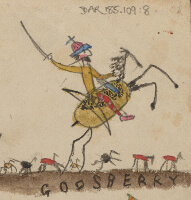
February Update
Our first release of 2015 sees the addition of 16 volumes to the Darwin Manuscripts collection. Amongst these, DAR 185 is especially interesting, containing marvellous hand-coloured drawings by Darwin’s children on the backs of heavily revised pages of the Origin of Species manuscript. Darwin himself showed little interest in preserving this draft, and these pages were kept for the children’s drawings rather than for their content. They give a fascinating glimpse into life inside the Darwin household, as well as further insights into the development of the Origin.
We are also releasing two new music manuscripts, MS Add.3389, a twelfth-century central Italian Gradual removed from the binding of an early printed book, and MS Doc.38, Indenture for the lease of a property by Mathew Holmes, which was formerly the wrapper of MS Nn.6.36, and was the document which identified Holmes as the scribe and owner of one of the most important collections of early lute music.
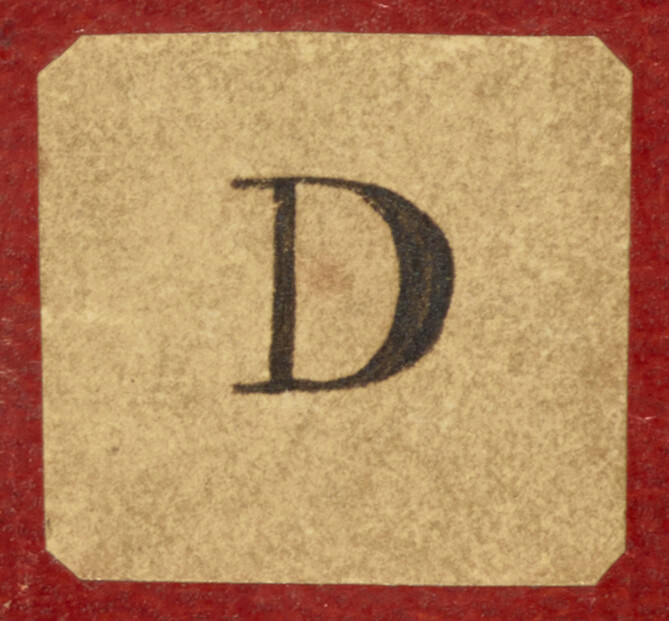
November Update
Our November release sees the launch of our Darwin Manuscripts collection, with a selection of papers charting the development of Darwin’ s evolutionary theory - from early theoretical reflections made while on board HMS Beagle to the publication of On the Origin of Species. Amongst many highlights are documents of worldwide importance such as the “Transmutation” and “Metaphysical” notebooks of the 1830s and the 1842 “ Pencil Sketch” which sees Darwin’s first use of the term “ natural selection”.
November also sees the conclusion of the main phase of the Sanskrit Manuscripts project, detailing more than 1,600 manuscripts, 500 of which are fully digitised. Along with important works from the many religious traditions of South Asia, including Vedic, Hindu, Buddhist and Jainist texts – the collection also includes texts on “ secular” topics, ranging from works of poetry and drama to treatises on philosophy, mathematics, grammar, astronomy, law, eroticism and medicine.
Finally, this release sees the introduction of new functionality to the website - allowing you to rotate images in the viewer, and also improving the user experience for those using the site on tablets and mobile devices.

October Update
In our October release we are celebrating the launch of our new Japanese Works collection. Cambridge University Library has extremely important holdings of early Japanese books and this initial selection includes examples of some of the earliest printing, and sumptuously illustrated scrolls.
We are also adding a further fourteen early printed books to our collections, in support of the forthcoming Private Lives of Print exhibition here at the University Library. Among the highlights are Ortus sanitatis, one of the first natural history encyclopaedias, and a beautifully printed book of hours.
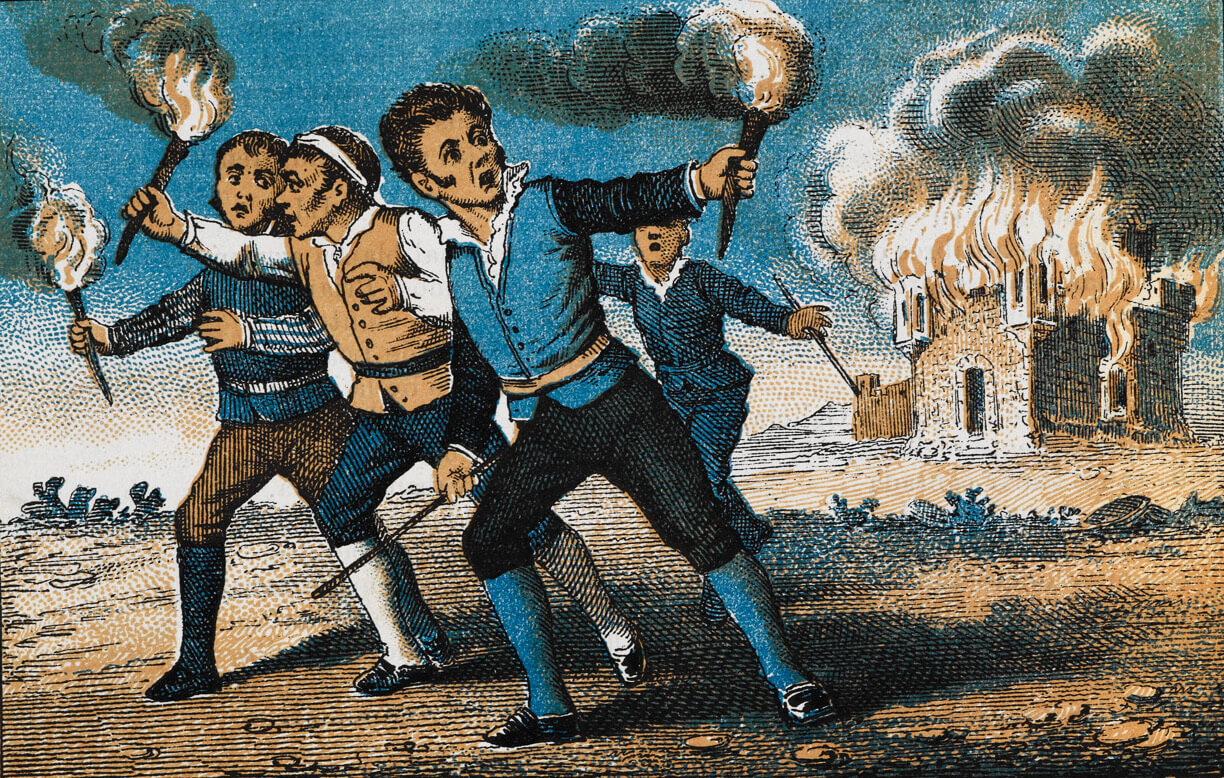
September Update
Our September release includes nearly four and a half thousand Spanish Chapbooks from the collections of the UL and the British Library. These fascinating predecessors of the yellow press provide a bird's eye view of popular culture in Spain from the eighteenth century onwards, including accounts of gory crimes, heroic criminals, and wayward citizens. The collection was catalogued and digitised for the AHRC-funded project 'Wrongdoing in Spain 1800-1936: Realities, Representations, Reactions’, which focused on particular aspects of the cultural representation of wrongdoing and its relation (or lack of it) to historical realities at the time of production. The material in this collection provides a unique base for tracking such interests within the field of popular literature.
We are also adding over thirty manuscripts to our Sanskrit Collection. Particular highlights include Add.1049.1, one of the oldest known dated Sanskrit manuscripts from South Asia, and Add.864, a masterfully crafted and intricately illustrated 16th-century Nepalese accordion book.
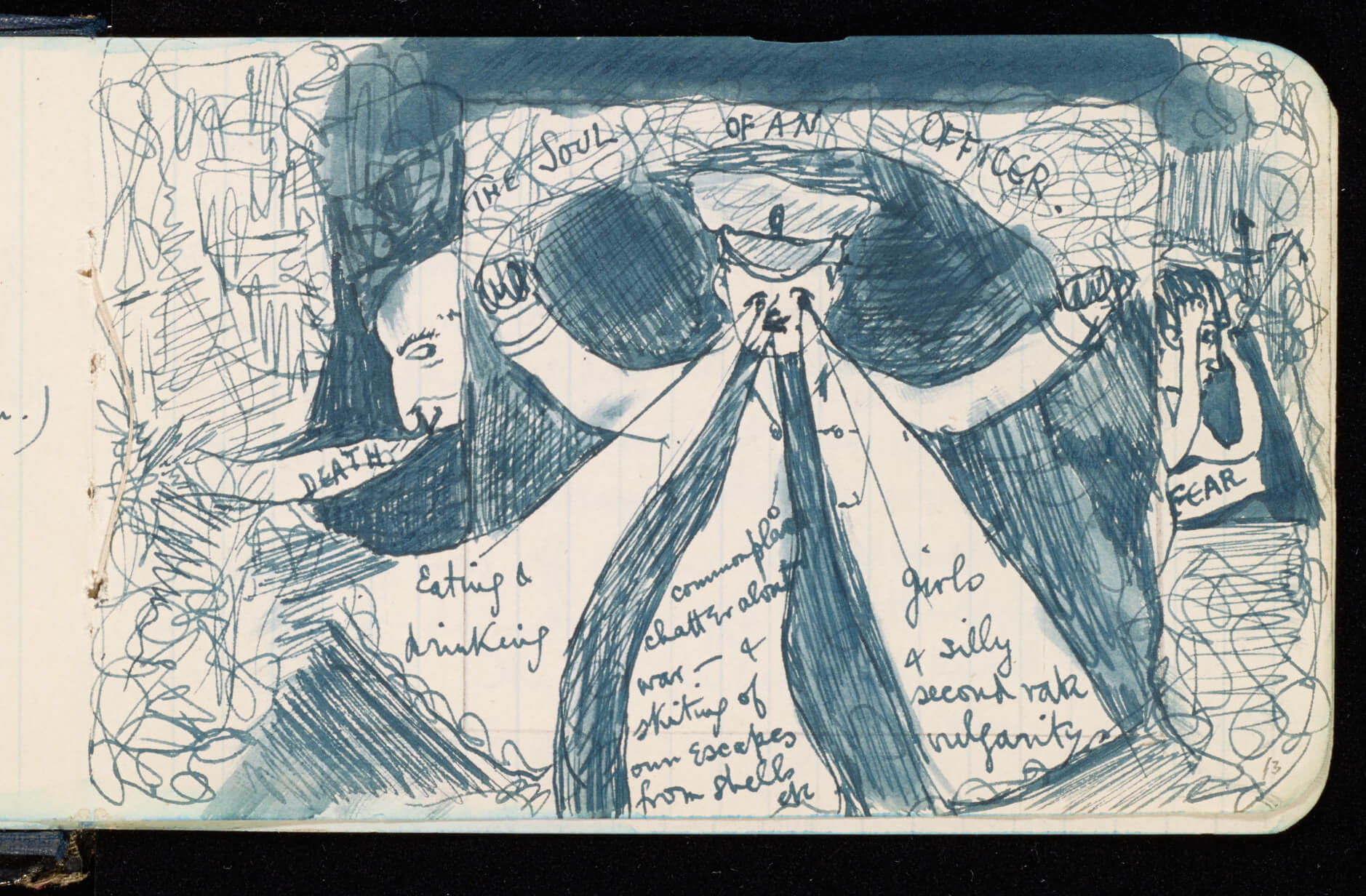
August Update
Our August release marks the 100th anniversary of the beginning of the First World War with the release of Siegfried Sassoon's wartime journals and poetry notebooks.
The journals give a fascinating insight into daily life in the trenches, including Sassoon's description of the first day of the Somme, the moment he was shot by a sniper at the Battle of Arras, and a haunting sketch of ‘the soul of an officer’. Two of the journals are marked with traces of mud and candle wax from Sassoon's time in the trenches.
The poems include previously unpublished material along with drafts of some of his best-known works including an early version of ‘ The Dug-Out’ with an additional, excised verse.
June Update
A particular highlight of our June release is a beautiful copy of Vesalius' Epitome, a companion piece to his Seven books on the fabric of the human body. Published in 1543 the Epitome includes a number of detailed anatomical woodcuts, as well as an extraordinary three-dimensional manikin.
To coincide with the opening of a major exhibition at the National Maritime Museum, we are making an important addition to our Longitude Collection. The Account of John Harrison and his chronometer is one of the most interesting and complex sources in the history of the Board of Longitude, detailing Harrison's long and often fraught relationship with the Board. Written from Harrison's point of view it provides an intriguing counterpoint to other material in the Collection, often describing the same events from a very different perspective. We have also taken the opportunity to enrich our presentation of the Papers of Nevil Maskelyne with a full, searchable index and table of contents.
Our Christian Collection continues to grow with the addition of MS CUL Ff.1.25, a composite manuscript made up of five different parts of different dates, compiled in the sixteenth century. Donated to the Library by Archbishop Matthew Parker in 1574, Ff.1.25 contains copies of many important medieval texts, including Geoffrey of Monmouth's Historia regum Britanniae.
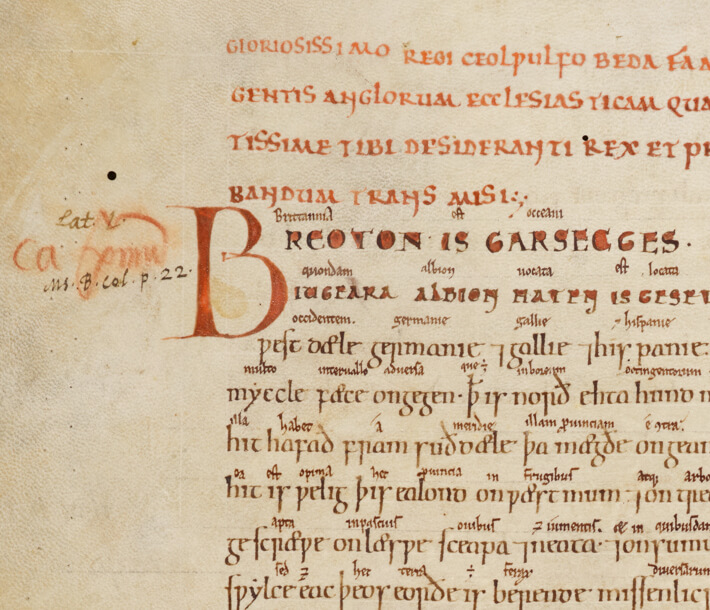
May Update
Our May release includes MS Kk.3.18 one of only five surviving copies of the Old English translation of Bede's Historia ecclesiastica gentis anglorum. Written in Worcester in the second half of the 11th century, it is extensively annotated in English and Latin, including notes added by the so-called 'Tremulous Hand', a scribe whose additions to numerous Worcester manuscripts are dated c. 1225-1250.
Of the fifteen new items in our Sanskrit Collection, a particular highlight is MS Add.1278, a wonderful example of an 'accordion book', containing a Tantric Buddhist text. Also included is MS Or.1818, a collection of devotional works of vaiṣṇava affiliation. Both are beautifully illustrated throughout. An additional highlight is MS Add.1698, which was composed in 1386 and is in the original hand of the author. Autograph Sanskrit manuscripts of this antiquity are extremely rare.
We are also adding over five hundred fragments to our Genizah collection. Among them are copies of the only known Medieval Hebrew poem by a woman (Mosseri VIII.202.2 and T-S NS 143.46), a 10th century letter which is believed to be documentary proof of the existence of Khazar Jews in Kiev (T-S 12.122) and a court record dealing with a famous case of murder (T-S 8.111).
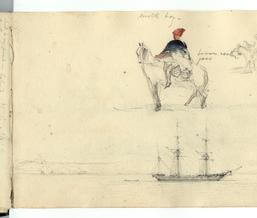
March Update
Among the many highlights of this release are two sketchbooks by Conrad Martens, the official artist aboard the Beagle from July 1833 to July 1834. The sketches and watercolours in MS Add.7983 and MS Add. 7984 include depictions of local landscapes, people, flora and fauna and give a vivid insight into what has become one of the most famous voyages in the world, owing to Marten’s shipmate and lifelong friend Charles Darwin.
There are two further important additions to our Christian Collection. The first is a fourteenth century copy of the Roman de la Rose , probably the most important and influential literary work written in medieval French. This manuscript is full of beautiful illustrations by Richard de Montbaston (fl. 1325-1353), a professional illustrator who lived and worked with his wife Jeanne (fl. 1338-1353) on the rue Neuve Notre-Dame in Paris. The second is the Breviary of Marie de Saint Pol, an illuminated prayer book commissioned by Marie de Saint Pol, Countess of Pembroke (c. 1304-1377) and founder of Pembroke College, Cambridge.
Also in this release are MS Or.476 and MS Or.771, two Qur'ānic fragments from the 9th or 10th century. This brings the total number of early Qur'āns and Qur'ānic fragments in our Islamic Collection to forty six, providing a rich resource for researchers.
Finally, we are adding a further fifteen manuscripts to our Sanskrit Collection, amongst which are beautifully illuminated copies of the Pañcarakṣā and Dhāraṇīsaṅgraha dating from the 17th and 18th centuries respectively.
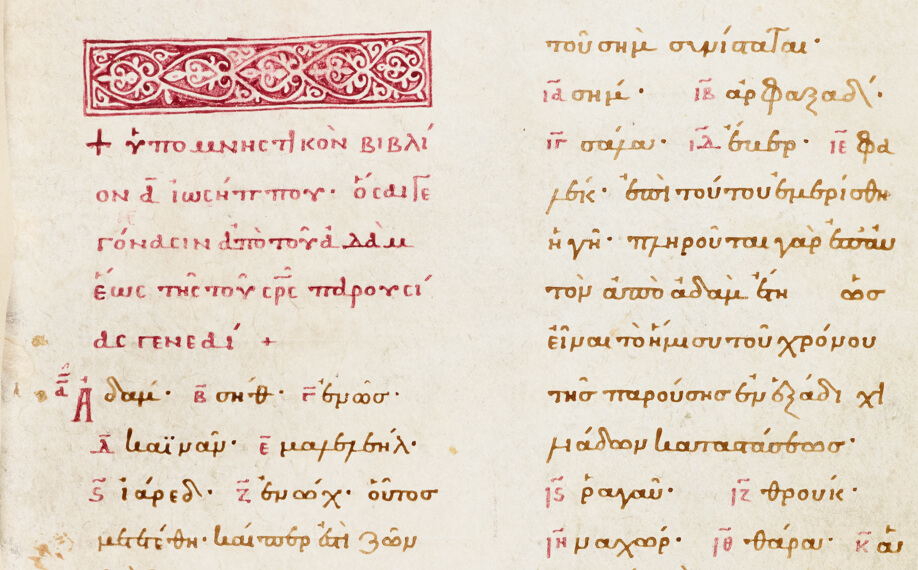
February Update
A major highlight of our February release is Ff.1.24, a Greek manuscript probably made in Constantinople in the tenth century. Owned and extensively annotated by Robert Grosseteste, consulted by Frances Bacon, and given to the Library by Archbishop Matthew Parker, this fascinating manuscript offers an insight into the working habits and library of one of the major intellectuals figure of the thirteenth century, and casts light on the tradition of Greek scholarship and transmission of Greek texts in the Medieval West.
We are also adding fourteen manuscripts to our Sanskrit Collection, including Add.1644 and Add.1647, two beautifully illuminated thirteenth century copies of the Pañcarakṣā or “ Five Protections”.
And we are releasing nearly five hundred additional fragments in our Cairo Genizah Collection, bringing the total number online to over sixteen thousand. Of particular interest is T-S 6J7.3, a letter from a man to his father, probably written after King Louis IX's Crusade was launched against Egypt. The writer refers to sudden announcements by the Muslim authorities of restrictions imposed on Christians and Jews, requiring them to wear distinctive clothing in the street on pain of forfeiture of life and property. Also included is T-S NS 98.73, a handy (quite literally) guide for calendar calculations using the fingers.
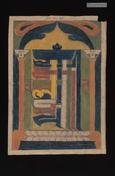
January Update
Our January release includes works spanning three continents and many centuries. MS G.1.1 is a fourteenth century compendium containing literary, historical, grammatical, scientific, astronomical, theological, pastoral and devotional texts written in three languages. It is beautifully illustrated with magnificent initials, diagrams and miniatures.
MS Add 9597/2/18 is an important addition to our collection of Isaac Newton’s manuscripts. It includes correspondence with major figures such as Edmund Halley, as well as Newton’s own notes on the Leibnitz controversy.
Two Hebrew items are included in this update. The first was something of a bestseller among fourteenth and fifteenth-century Jewish doctors. Nathan ben Joel Falaquera's compendium of medical knowledge, Balm for the Body, aimed to condense the medical knowledge of the ancient and Islamic worlds and present it in an easily accessible manner to a European Jewish audience. Our copy was a prestigious edition, adorned with illuminated headings and fine pen and ink drawings. The second Hebrew item, from Italy, also belonged to a popular genre, this time of the eighteenth century: a map of the holy places of Jerusalem, along with other significant burial sites in the Land of Israel, all drawn schematically. It shows real artistic skill and is one of the finest examples of this type of folk art.
Finally, we have added forty five manuscripts to our Sanskrit collections, including twelve with images. Particular highlights include a polychrome charm against lightning and a twelfth century illuminated copy of the Vasudhāradhāraṇī, one of the earliest extant manuscripts of this text
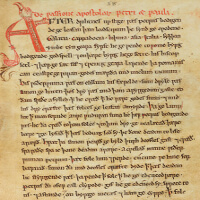
December Update
The December update to the Digital Library includes two important additions to our Christian Manuscripts collection. Hh.1.10 is a copy of Ælfric's Grammar and Glossary produced in Exeter about the time of the Norman Conquest. It is written in Old English and contains a copy of one of the earliest Latin grammars written in the vernacular. Ii.1.33, also by Ælfric, was copied about a century after the Norman Conquest and contains homilies in Old English for many different feasts and saints, including St Æthelthryth who founded Ely Abbey. Both manuscripts were donated to the University Library in 1574 by Matthew Parker.
We are also releasing a number of new manuscripts in our Sanskrit collection, including a 14th century copy of the Pañcarakṣā with covers decorated with representations of the five Buddhas of directions and the five goddesses of protection.
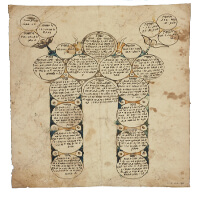
Over 15,800 items from the Cairo Genizah now online...
The most recent update to the Genizah Collection on Cambridge Digital Library contains an additional 4000 items encompassing both the discovery of the fragments themselves, and some of the earliest written pieces in the Collection.
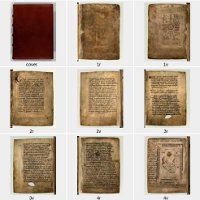
Early Qur'anic manuscripts and Thumbnail View
In this release, we present the full collection of our earliest Qur'anic manuscripts copied during the first four Centuries of Islam, including a portion of the earliest Qu'ran for which we have an evident terminus ante quem.
We have added 15,000 pages of material from the National Maritime Museum's print holdings to our Board of Longitude Collection.
And we have introduced new functionality to allow you to quickly scan through manuscripts - simply click on the "Thumbnails" tab on the right hand side of the screen when viewing any item.
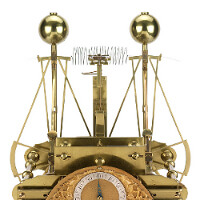
Launch of the Board of Longitude Collection
With the official launch of our Jisc-funded Board of Longitude project, we are releasing the full digitised archive of the Board and accompanying material. These papers throw a vivid light on the role of the British state in encouraging invention and discovery, on the energetic culture of technical ingenuity in the long eighteenth century, and on many aspects of exploration and maritime travel in the Pacific Ocean and the Arctic. The digitised material is supported by a detailed framework of metadata, summaries, essays, videos and educational resources to create a rich and exciting resource for researchers, teachers, students and the general public.

Page-by-page searching
Fundamental changes have been made to the search functionality, giving clearer page-by-page results with thumbnail images.
The Virtual Exhibitions site is now live at https://exhibitions.lib.cam.ac.uk/ and links have been added to relevant items to integrate with the Digital Library.

Virtual exhibits
We have created a new collection to gather together items being featured in Library exhibitions. The initial selection provides a sneak preview of Spanish and English pamphlets appearing in our 'Wrongdoing' exhibition, which opens to the public on 30th April. These items will also feature in an accompanying exhibition website and we will link them to that site once it is launched later this month.
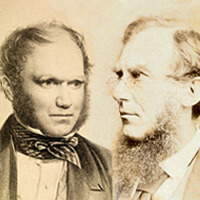
Browse 1,200 letters between Charles Darwin and his close friend Joseph Hooker
These letters are a connecting thread that spans forty years of Darwin's mature working life from 1843 until his death in 1882. They bring into sharp focus every aspect of Darwin's scientific work throughout that period, and illuminate the mutual friendships he and Hooker shared with other scientists, but they also provide a window of unparalleled intimacy into the personal lives of the two men.
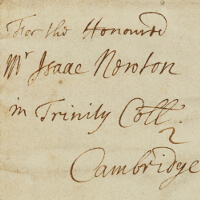
Maimonides fragments and Newton's dispute with Flamsteed released
In this release we are publishing a further 8,000 Genizah fragments, bringing our overall total to 12,000 available on the site. The Cairo Genizah Collection at Cambridge University Library is the world's largest and most important single collection of medieval Jewish manuscripts, and this selection includes three autograph texts by the greatest Jewish thinker of the Middle Ages, Moses Maimonides (T-S AS 111.164, T-S AS 149.89 and Mosseri VIII.24.1)
We are also releasing three Newton manuscripts - including MS Add.4006, which contains Newton's correspondence with John Flamsteed, the first Astronomer Royal. The correspondence touches on the dispute between Flamsteed and the Royal Society (of which Newton was the President) over the publication of Flamsteed's observations. Newton required real observations of the Moon's place for his theoretical work, and Flamsteed, who was the holder of those observations, resented Newton's imperious demands. In 1712 publication went ahead without Flamsteed’s agreement, incensing the Astronomer Royal who referred to this as a 'villainous outrage'.
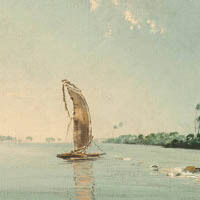
Log book of Captain Cook's astonishing Pacific and Antarctic voyage now online
In this release we are presenting an initial selection of our Longitude collection, including papers from the astonishing Pacific and Antarctic voyage of James Cook in 1772-1775. The digitised archive of the Board of Longitude, the majority of which will be released in July 2013, is a major resource for the history of science, and throws a vivid light on the role of the British state in encouraging invention and discovery, on the energetic culture of technical ingenuity in the eighteenth century, and on many aspects of exploration and maritime travel in the Pacific Ocean and the Arctic. We are also releasing eighteen further Newton manuscripts, including correspondence with major figures such as Halley and Flamsteed.
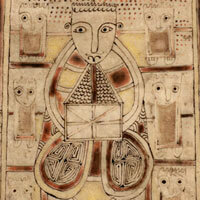
Build your own Digital Library with our Bookmarking tool
This release sees new bookmarking functionality which allows you to build your own digital collection within the Cambridge Digital Library. This is the first of many planned features for personal interaction with our material. We have also released some exciting new content, including two brand-new collections. Our initial selection of Christian Works includes a fully-transcribed presentation of the 4th century Biblical text the Codex Bezae, along with the earliest known Scottish manuscript, the Book of Deer. Among our Hebrew manuscripts is the Nash Papyrus, a second-century BCE fragment containing the text of the Ten Commandments. We have added important material to our Sanskrit and Islamic collections, and our Treasures collection now includes Henry VIII's personal copy of Erasmus' translation of Plutarch. We have also added over 3,000 new Genizah fragments, more than trebling the number of items available.
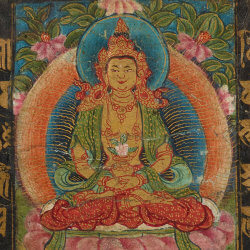
Launch of Sanskrit and Spanish Chapbook Collections
We have added more items to the Islamic Manuscripts and Newton collections - and have initiated two new collections: the Sanskrit Manuscripts and Spanish Chapbooks. Both these collections will grow over the next two years. We are also continuing to improve functionality, allowing you to search within transcribed manuscripts, displaying more information about each document and making bookmarking an individual page easier.

View the Library's treasures cover to cover
We have added more items to the Islamic Manuscripts and Newton collections - including several videos explaining Newton's work and ideas - and have initiated two new collections: the Cairo Genizah collection and Treasures of the Library. Both these collections will grow considerably over the the next few months. The initial Genizah collection includes a selection of seventy-two manuscripts, intended to show the wide range of material in this fascinating collection. Among the Treasures we've added to the Digital Library are the Codex Bezae, Life of St Edward the Confessor, Nuremberg Chronicle, and Montaigne's copy of Titi Lucretii Cari De rerum natura libri sex. The last three works are featured in the current Library exhibition, Shelf Lives . Now you can view these treasures in great detail, from cover to cover.
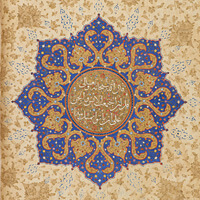
Islamic Manuscripts
We are pleased to announce the release of the first items within the Foundations of Faith collection: a selection of Islamic manuscripts from the Library's Near and Middle Eastern Department. The Library's collection of Islamic manuscripts began in the 1630s and has since grown substantially in its size and diversity. It now contains more than 5,000 works. Our initial selection includes several important early Qur'ans.
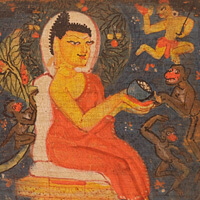
Upcoming Collections
In addition to the digitisation we have already planned for the Cambridge Digital Library, we are pleased to announce two externally-funded projects which will add significant content. The AHRC are providing funding for the cataloguing of our important Sanskrit manuscript collection, which includes some of the earliest surviving Buddhist manuscripts. Approximately 1000 of these manuscripts will be digitised and made available within the Cambridge Digital Library's Foundations of Faith collection. The JISC are funding the complete digitisation of the Board of Longitude papers, which provide a fascinating record of 18th century science and technology and the great voyages of discovery. This collection will be made available as part of the Foundations of Science collection and closely linked to collections held by the National Maritime Museum at Greenwich. Please contact us for more information about these projects.
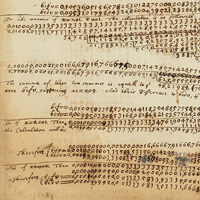
Introducing the Cambridge Digital Library
Over the next two years we will be adding a lot of content and functionality to this website. You'll be able to explore many of the Library's great collections and make use of them within your research and learning - whether that takes place within formal education or is a personal pursuit. Find out more about the Cambridge Digital Library.


